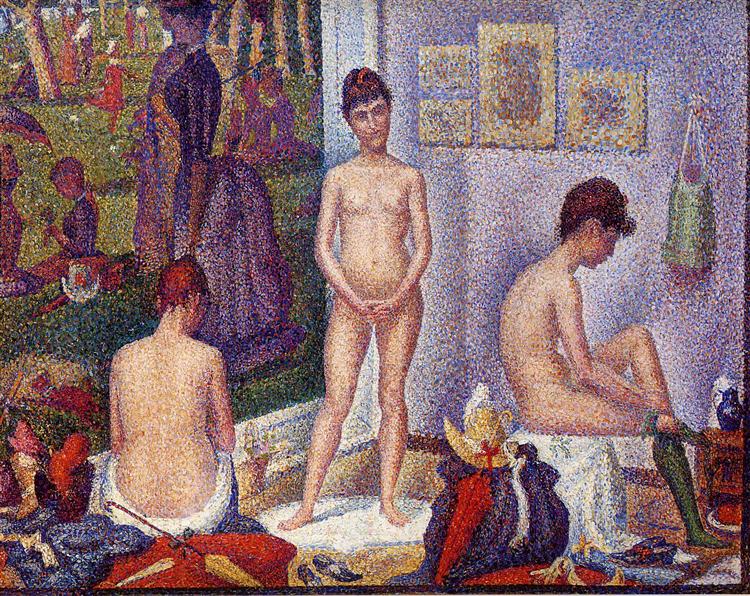Beskrivelse
Georges Seurat, one of the most prominent figures of Post-Impressionism, is known for his innovative approach to colouring and the dot technique, a method known as pointillism. His work The Models (1888) fits into this context, representing a fusion of his pictorial experimentation and a reflection on the human figure within the artistic space. The painting is a fascinating study of body and form, depicting a series of models in positions that evoke both contemplation and the solidity of the craft that painting requires.
In The Models, Seurat presents a group of nude women, portrayed in an intimate and private setting, where the contrast between the luminosity of their skin and the darker background of the studio highlights the shape and texture of their figure. Each model, seated or reclining on a soft surface, appears to be absorbed in her own existence, which adds a psychological dimension to the work. Seurat's choice to show these models in a state of repose, rather than action, allows the viewer to contemplate the proportions and beauty of the human figure without distraction.
The composition in The Models is dynamic despite its apparent stillness. The arrangement of the figures guides the viewer's eye through the scene, from the most central figure to those flanking them in the background. The curves of the models' bodies are effectively contrasted by the straight, structured lines of the surroundings, creating a tension that is characteristic of Seurat's work. Furthermore, his use of color is meticulously deliberate; the palette, composed of earthy tones and skin hues, is complemented by hints of blue and green, providing a sense of depth and volume that draws the eye to the more nuanced details.
The pointillism technique that Seurat adopted reinforces this exploration of light and colour, as each point of paint contributes to the total visual perception of the image, inviting the viewer to adopt an active stance when observing. This method, as well as being a manifestation of his scientific experimentation with colour theory, also establishes a connection between the work of art and the mind of the observer. Seurat, through his meticulous treatment of light and colour, manages to transform what could have been a simple portrait of models into a meditation on perception and representation.
In the tradition of academic art of its time, The Models can be seen as an affirmation of the human figure, a recurring theme in art since ancient times. By depicting these nude women in a way that evokes both beauty and vulnerability, Seurat participates in a broader dialogue about the role of models in art history and their relationship to the artist. One can think of this work as a commentary on the painter's work in the representation of form, as well as on the very existence of the models who, often invisible in the creative process, become protagonists in this painting.
The Models falls within the broader context of Post-Impressionism, a movement that, through a number of artists such as Vincent van Gogh and Paul Cézanne, sought to challenge contemporary notions of representation. In Seurat’s work, this quest translates into a unique technique that explores color and light, while raising questions about art and the role of the human figure. Thus, The Models becomes an object of study not only for its aesthetic beauty, but also for the depth of its conceptual implications, a testament to Seurat’s genius and his lasting impact on modern art.
KUADROS ©, a famous painting on your wall.
Hand-made oil painting reproductions, with the quality of professional artists and the distinctive seal of KUADROS ©.
Painting reproduction service with satisfaction guarantee. If you are not completely satisfied with the replica of your painting, we will refund 100% of your money.

